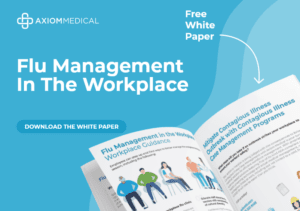A workplace injury can trigger more than physical pain—it often brings confusion, anxiety, and a flood of questions. “Do I need to go to the ER?” “What happens next?” “Will this affect my job?”
Traditionally, injury response has relied on reactive processes: phone calls, forms, delays, and decisions made with limited context. But today, we’re entering a new era—one where artificial intelligence (AI) in injury case management is beginning to support faster data processing, trend recognition, and workflow efficiencies.
Still, AI alone isn’t enough.
With a background in nursing and health engagement, I’ve seen firsthand how both speed and empathy are essential to meaningful injury care.
While AI tools are advancing rapidly across the healthcare and workplace safety space, many solutions are still evolving. Our role—as injury care professionals and health partners—is to thoughtfully explore how these technologies may support better outcomes without replacing the human element.
Injury care is personal. It’s emotional. It’s high-stakes. While AI enhances precision and efficiency, it’s empathy—delivered through education, communication, and human support—that ensures care truly connects.
The future of injury case management isn’t just data-driven. It’s data-informed and human-delivered.
Note: Axiom Medical does not currently use AI in clinical decision-making. This article explores how AI tools are evolving across the industry—and how we are thoughtfully engaging with these developments to help shape the future of care.
1. What AI Can Do: Enhancing Injury Care with Intelligence
Studies show that early reporting can reduce claim costs by up to 52%.* That statistic alone underscores why smarter, faster response systems matter.
*Based on internal aggregate findings from 2018–2024 across select high-reporting client populations.
AI is beginning to reshape how organizations approach workplace health. Emerging tools show promise in detecting patterns, streamlining workflows, and providing teams with real-time context to inform their next steps.
Examples of AI’s role in injury care:
- Predictive analytics: Identifies high-risk roles and locations based on trends
- Smart documentation tools: Speeds up reporting and reduces admin burdens
- Automated flagging: Surfaces fatigue or behavioral health risk factors
- Benchmark dashboards: Gives employers insight into incident rates and risk areas
These tools are powerful—but only if they’re used intentionally. That’s where health engagement professionals come in: to ensure insights are understandable, actionable, and human-centered.
2. Why Empathy Still Matters—Especially in an AI-Enabled Future
AI can support the process. But only humans can deliver real reassurance.
An employee who just got hurt isn’t thinking about technology—they’re thinking about their pain, their paycheck, and their peace of mind. They need clear answers—and someone who can meet them with calm, clarity, and compassion.
AI can streamline processes and suggest next steps, but it can’t hear the quiver in someone’s voice when they’re trying not to cry—or pause to say, “I’m here for you.”
That’s where empathy comes in:
- It builds trust in moments of uncertainty.
- It drives better outcomes through clear communication and care.
- It increases compliance because people feel heard and supported.
Empathy is a strategic advantage. As AI takes on more behind-the-scenes work, human connection becomes even more vital to recovery and engagement.
3. Where Health Engagement Fits In: Making AI Make Sense
Health engagement bridges the gap between smart systems and human needs.
Injury case management isn’t just clinical anymore—it’s educational and behavioral. Health engagement ensures people understand what’s happening, what to expect, and what to do.
How AI and health engagement work together:
- AI flags late reporting trends → Engagement teams create proactive education
- AI detects fatigue patterns → Communications emphasize hydration, sleep, and breaks
- AI may help identify behavioral health trends → Engagement teams can reinforce safety training with supportive messaging
- AI benchmarks performance → Health engagement turns data into next steps
Think of AI as the instrument panel—and health engagement as the pilot. You still need humans to navigate the emotional, cultural, and practical elements of recovery.
4. Looking Ahead: A Smarter, Kinder Injury Response System
The future isn’t just about technology. It’s about how we use it to protect people.
Where the industry is headed:
- Real-time risk detection and intervention
- Personalized recovery recommendations
- Data-informed safety culture improvements
- Communication strategies that reduce stigma and delay
Top-performing organizations will thoughtfully explore how predictive insights might pair with plain-language education, proactive outreach, and trusted guidance.
Interest in AI-driven tools will likely continue to grow in the years ahead. But empathy will remain the differentiator—and that’s where the real advantage lies.
5. Final Word: The Sweet Spot Between Intelligence and Impact
I like to think of it as the E³ Model: Empathy × Education × Engagement—powered by intelligence, delivered by humans. It’s how we ensure technology works in service of people, not the other way around.
We often talk about AI in terms of speed and scale—and yes, that matters. But in injury care, impact is measured in trust earned and outcomes improved.
AI reveals the patterns. Empathy guides the response.
At Axiom Medical, we believe care should be fast and compassionate. Clinically sound and emotionally supportive. And as we look forward, I’m more convinced than ever:
AI won’t replace the human touch—it can help clear the path for it.
Because when empathy meets intelligence, injured workers don’t just receive support—they feel cared for. And that changes everything.
If you’re responsible for injury care, safety culture, or employee well-being—ask yourself: Are we combining smart systems with human support? If not, this is your opportunity to lead that change.
Let’s talk about what that looks like in practice.










